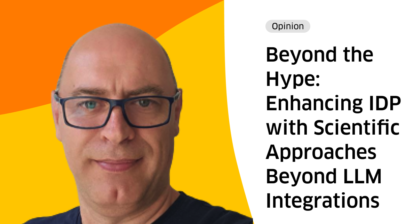Curious about what keeps experts, CEOs and other decision-makers in the Intelligent Document Processing (IDP) space on their toes? Get food for thought on IDP-related topics from the industry’s leading minds.
In this opinion piece, Ben Cheng, Founder and CEO at IDP provider FormX.ai, explores the challenges organizations face in prioritizing data security when using large language models (LLMs) for IDP and discusses alternative approaches that enable organizations to leverage the power of LLMs for IDP while maintaining robust data security practices.
Large Language Models (LLMs) have emerged as powerful tools for Intelligent Document Processing (IDP). Their ability to extract information, answer questions, and automate tasks from documents can significantly improve efficiency and accuracy. However, for organizations prioritizing data security, utilizing LLMs for IDP presents unique challenges, particularly when considering on-premise deployment.
This article explores these challenges and discusses alternative approaches that enable organizations to leverage the power of LLMs for IDP while maintaining robust data security practices. We’ll delve into the limitations of on-premise deployment, explore cloud-based security options, and introduce promising open-source LLMs as alternatives. By understanding these considerations, organizations can make informed decisions about incorporating LLMs into their secure IDP workflows.
Limited Model Choice: The Achilles’ Heel of On-Premise LLM Deployment for IDP
One of the biggest challenges for organizations seeking to leverage LLMs for IDP with data security in mind is the limited availability of powerful models for on-premise deployment. Here’s a deeper dive into why this is a significant hurdle:
- Computational Demands: The most powerful LLMs, such as GPT-4 and Gemini Ultra, boast trillions of parameters, requiring immense computational resources to function effectively. On-premise environments often lack the high-performance hardware infrastructure (e.g., specialized GPUs) necessary to train and run these models efficiently. For example, Llama-3-70b can run with two 4090 quantized, but it is still slow.
- Economic Bottleneck of On-Premise LLMs: The high cost of powerful hardware (e.g., A100s) for on-premise deployment can be economically infeasible, especially for spiky workloads where expensive resources may be underutilized after initial processing surges.
- Cost Considerations: Setting up and maintaining the necessary on-premise infrastructure for powerful LLMs is a significant financial investment. This includes the cost of hardware, software licenses, and ongoing maintenance for the complex computing environment.
- Limited Vendor Support and Upgrade Challenges: On-premise deployments typically receive less ongoing support from LLM vendors compared to cloud-based offerings. Additionally, upgrading to newer, potentially more powerful LLM versions often requires significant development effort to integrate and adapt the model to existing workflows. This can be a time-consuming and costly process, especially for organizations with limited resources.
Data Minimization and Anonymization: Safeguarding Sensitive Information in Cloud-Based LLM Workflows
While on-premise deployment presents challenges for powerful LLMs, cloud-based solutions offer a wider range of models and greater scalability. However, data security remains a top concern for organizations utilizing cloud-based LLMs for IDP. This is where data minimization and anonymization techniques come into play as crucial alternatives for safeguarding sensitive information.
- Data Minimization: This approach focuses on extracting only the specific data points required from documents for IDP tasks. By minimizing the amount of data the LLM interacts with, the attack surface for potential data breaches is significantly reduced.
Imagine an LLM tasked with processing invoices. Data minimization would involve extracting only essential information like vendor names, invoice amounts, and due dates. Any extraneous data on the invoice, such as customer names or social security numbers, would be excluded from the processing pipeline.
- Anonymization: This technique involves transforming sensitive data into a non-identifiable format before sending it to the cloud for LLM processing. Common anonymization methods include:
- Tokenization: Replacing sensitive data with unique tokens that don’t hold any intrinsic meaning.
- Masking: Redacting sensitive data with characters like asterisks (*) or replacing it with generic placeholders.
- Pseudonymization: Substituting real data with fictitious but similar data that preserves the format (e.g., replacing a real name with a generated name).
By implementing these techniques, organizations can leverage the power of cloud-based LLMs for IDP while minimizing the risk of exposing sensitive information. The LLM operates on the anonymized data, performing its tasks without ever needing to access the original, identifiable information.
The Hybrid Cloud Approach: Balancing Scalability and Security with On-Premise Preprocessing
The hybrid cloud model presents a compelling alternative that leverages the strengths of both on-premise and cloud environments for secure IDP with LLMs.
The Core Concept:
In a hybrid cloud model, organizations establish a two-stage data processing pipeline:
- On-Premise Preprocessing and Anonymization: Sensitive data is first processed on-premise. This stage involves techniques like data minimization and anonymization discussed earlier. Here, the organization extracts only the necessary data points and transforms sensitive information into a non-identifiable format.
- Cloud-Based LLM Processing: The anonymized data is then uploaded to the cloud environment. Here, the cloud-based LLM leverages its capabilities to perform tasks like information extraction, question answering, and document classification on the anonymized data.
Promising Open-Source Options: Empowering Secure IDP with Llama 3 and Beyond
While the most powerful LLMs currently reside behind closed doors at major corporations, the open-source LLM landscape is rapidly evolving. This presents a promising alternative for organizations seeking secure IDP solutions, particularly those with limited budgets or a strong preference for open-source technologies.
Llama 3: A Leading Open-Source LLM Contender
One of the most exciting advancements in open-source LLMs is Llama 3. While it may not compete with the raw power of closed-source giants like GPT-4, Llama 3 demonstrates impressive capabilities:
- Fine-Tuning Potential: Open-source LLMs like Llama 3 offer greater flexibility for customization. Through fine-tuning on specific datasets relevant to an organization’s IDP tasks, Llama 3 can achieve performance comparable to larger models in some cases. This allows organizations to tailor the LLM to their specific document processing needs within the IDP workflow.
- Transparency and Control: Open-source LLMs provide greater transparency into the underlying code and algorithms. This allows organizations with security concerns to perform their own audits and ensure the LLM is not introducing hidden vulnerabilities. Additionally, open-source models offer more control over deployment and updates, empowering organizations to tailor the LLM to their specific security requirements.
- Cost-Effectiveness: Open-source LLMs eliminate licensing fees associated with proprietary models. This can be a significant cost advantage, especially for organizations with limited budgets or high document processing volumes.
Beyond Llama 3: The Evolving Open-Source LLM Landscape
Llama 3 represents a significant step forward, but it’s just the beginning. The open-source LLM community is constantly innovating, with new models and advancements emerging rapidly. Organizations can stay informed about the latest open-source LLM developments to identify the most suitable option for their IDP needs.
Secure IDP with LLMs – A Cloud-Centric Future with Hybrid Options
Large Language Models (LLMs) are transforming Intelligent Document Processing (IDP), offering unparalleled automation and data extraction capabilities. While data security remains a top concern, especially for on-premise deployments, we believe cloud-based LLMs will continue to be the mainstream solution due to their scalability and access to the most powerful models.
The key lies in designing secure workflows that leverage the strengths of both cloud and on-premise environments. Techniques like data minimization, anonymization, secure enclaves, and the hybrid cloud model can ensure sensitive information remains protected while enabling organizations to harness the power of cloud-based LLMs for efficient IDP.
For organizations with budget constraints or a strong preference for open-source solutions, promising options like Llama 3 offer a secure and customizable alternative within the cloud-centric future of IDP. By carefully crafting secure data flows and exploring the evolving LLM landscape, organizations can unlock the full potential of LLMs for streamlined and secure document processing workflows.

About the Author
Ben Cheng is the CEO of SkyMakers Digital, an international software product studio fostering collaboration among a global team. They create exceptional digital products (Oursky), offer an open-source authentication product (Authgear), and leverage AI for document processing (FormX.ai). Beyond work, Ben is passionate about giving back to the IT industry and advocating for freedom and democracy.
📨Get IDP industry news, distilled into 5 minutes or less, once a week. Delivered straight to your inbox ↓







